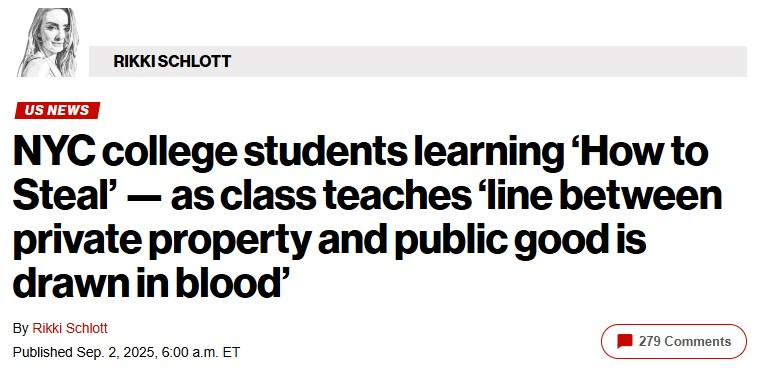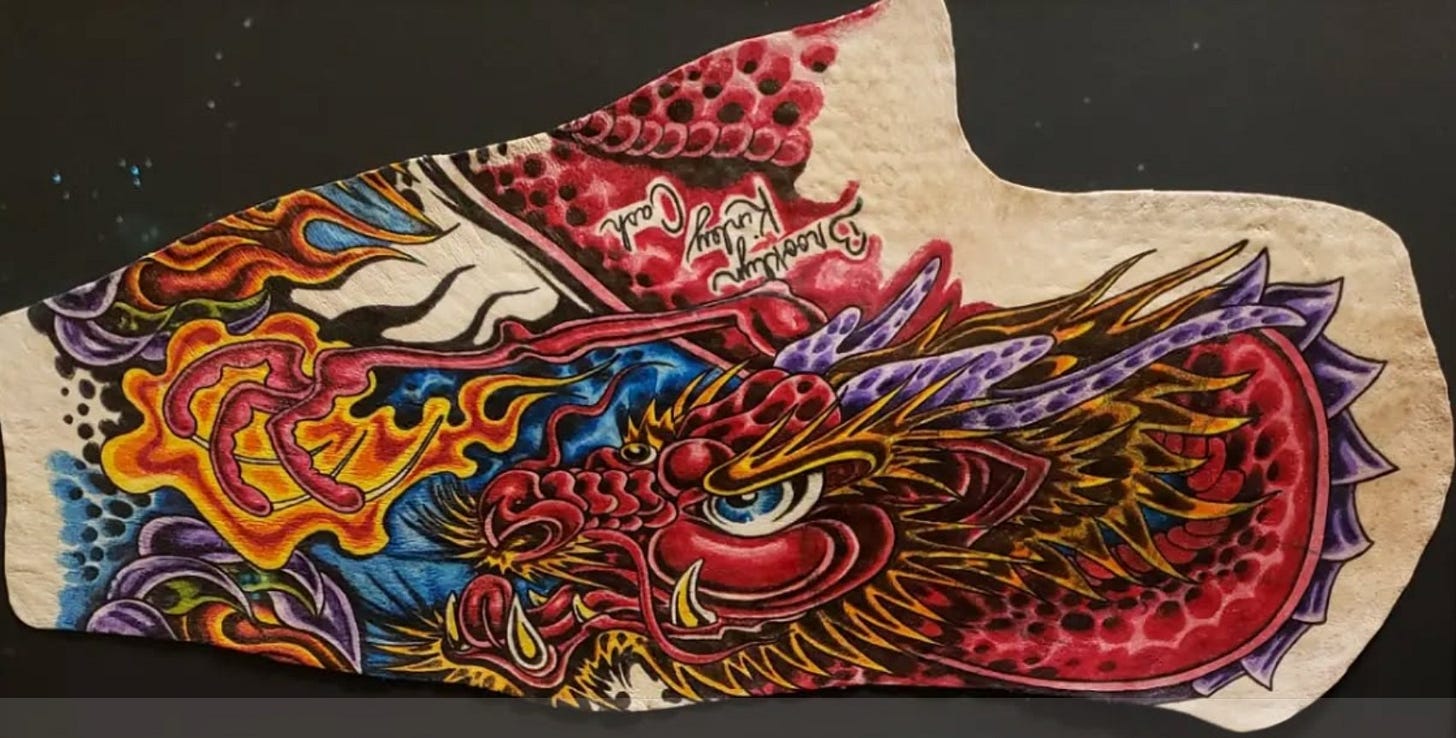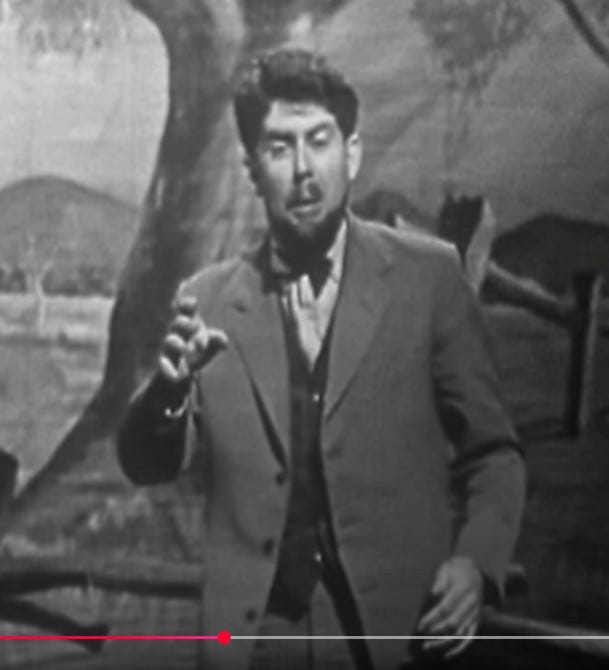Number 4. New York Post. College students can take a class to learn how to steal.
Move over, street gangs. Organized theft has gone mainstream, and terms like “ethical robbery” are not the oxymorons you might have thought.
Several Ivy League universities have upped their game in cultural enlightenment by offering serious coursework in subjects that sound like something from a Saturday Night Live script of 20 years ago.
At the Eugene Lang College of Liberal Arts, part of a Manhattan private university called New School, students can enroll in a 4-credit-hour course titled “How to Steal.” According to the course outline, it “explores the politics, ethics and aesthetics of theft” in modern life.
That modern life is condemned as a place where “accumulation is sacred, dispossession is routine, and the line between private property and public good is drawn in blood.” Clearly, suggests the course, those archaic values are oppressive, unjust, and need to be changed.
A pithy challenge illustrates the world view of the class: “Is it possible to steal back what was already stolen?” Students will be expected to develop “speculative strategies for redistributing wealth, knowledge and beauty.”
Tuition at New School runs $62,240 per year, not including housing, making this particular course cost $10,040. One might argue the cost to Western Civilization might be much higher.
There are similar trends in classes offered at New School’s Ivy League counterparts:
Columbia University: “Game of Thrones, a prototype for a comparative understanding of the larger question of epics and empires.” The course is entirely devoted to studying the HBO series, complete with required discussion groups.
Princeton: “Gaming Blackness: The Anthropology of Video Games and Race.”
Yale: “Bad Bunny: Musical Aesthetics and Politics.” I have no idea who or what “Bad Bunny” is.
Brown: “Prison Abolition as Policy.” As homework, students create TikToks to share their thoughts.
NYU: “Indigenous and Latinx Speculative Film and Fiction,” “Queer Cultures,” and “Disability and Sexuality in American Culture.”
Harvard: “Taylor Swift and Her World.”
At tuition rates nearing $100,000 per year, one wonders what lucrative careers such classes might make available to students. My guess is they will end up back in a university setting, teaching more of the same.
No doubt there are solid, respectable and profitable courses of study at each of the above. But the hiring manager at a major corporation may be reasonably suspicious of the job applications he is now seeing.
Number 3. The Mary Sue. Smart TVs may be watching and listening inside your home.
When a Walmart shopper named Helene bought a TV set that had been previously purchased by a friend and then returned, she got a good deal on the price. However, the Roku-enabled set came with other features she had not expected.
While browsing the capabilities of the new device, Helene found that she was watching live camera feeds from the interior of her friend’s home.
The friend had installed video cameras in various rooms and connected them wirelessly to Roku. When logged onto her Roku account, she could then observe other areas in her house from the TV set.
It might have been a good idea to log out of her Roku account before she returned the smart set to Walmart, but that may be a detail of modern life easy to overlook. It’s no wonder so much private information now circulates on the web.
Helene, who as luck would have it, is also popular on TikTok, thoughtfully published a video showing how she could see the inside of her friend’s house. It got a quarter million views.
Now, that’s all an interesting insight to another risk of life in this digital age, but a cynic might raise a few questions:
Why would you want cameras positioned in various rooms in your home that you can browse from your TV set? What do you think might be going on there?
Is there more to this story than the mere coincidence of one woman purchasing a TV set, equipping it with cameras, and returning it to be purchased at a discount by a friend? What are the odds that I would go to my local Walmart and buy a model that my very own neighbor had just returned?
Are 250,000 TikTok views worth money to Helene? If yes (and probably so) is it remotely possible that she and her friend might have come up with a plan to create such buzz?
As I say, only a cynic would ask. But the story is a useful reminder to not do stupid things in a world where every digital move you make can be documented and shared.
Number 2. AP News. Lithuania to open drone training centers.
In a sign of the times, the government in Vilnius is sponsoring drone training to teach thousands how to build and fly the machines.
Drone attacks are the face of modern warfare. Ukraine plans to launch over 4 million of the devices against Russia this year. There is a rich market in drone training across the NATO civilian population of nearly 3 million who live along the borders with Russia and Belarus.
Nine training centers will be built in Lithuania at a cost of $3.8 million USD to equip students in the art and science of drone operation. Children will be introduced as early as third grade.
High schoolers will learn to build and fly the “first-person view” drones which have been so effective in targeting and eliminating enemy soldiers at the individual level.
And here I have been thinking we should have firearms training in American public schools, focused on both hobby target shooting and safe operation.
Am I out of touch, or what? Forget the shotguns; drones are the next big thing.
Number 1. Popular Science. Father-son morticians turn tattoos into wall art.
To help start your weekend with a particularly ghoulish selection, we turn to Popular Science, where we review the profitable art of preserving tattoos from your deceased relatives.
Kyle Sherwood, a mortician with an artistic streak, founded Save My Ink in 2017 with his father. The father took some convincing, but Kyle was convinced there was money to be made by the funeral home in offering to preserve chunks of the loved one’s skin that had been ornamented with a tattoo.
It is, argued the younger Sherman, not unlike preserving Mom’s ashes in an urn on the mantle.
In practice, a whole piece of skin encompassing the desired tattoo is surgically removed from the cadaver within 3 days of… well, within 3 days of expiration. If you are a mortician, not to worry about the procedure: Save My Ink will provide a video tutorial with step-by-step instructions. The removed… err… parchment… is then preserved in a secret sauce not too distant from formaldehyde, and shipped to Save My Ink for processing.
The processing part is also a secret, but the finished product is placed under museum-quality glass, framed, and returned to the funeral home for delivery to the family.
There is an untapped market at work here. Estimates are that over one-third of Americans sport a tattoo of some sort. In virtually every case, the ink portrays something important about the subject’s life or ambitions.
If Bill Gates has his way, the population with tats may approach 100% of us in the next decade. The nanocapacitor-enabled tat may replace your smartphone. I hope it’s attractive.
Turning the tat into a hanging portrait costs around $1700 US, not unlike the cost of a funeral urn with post-cremation ashes. (A full-body wrap, however, can be up to $100,000… but that is a concept not worth thinking too much about.)
So… how did the Mssrs. Sherwood first learn the techniques required for this? They acquired left-over skin from tummy-tuck procedures, contributed by subjects who agreed to be tattooed prior to the operation. Makes perfect sense.
And no, Save My Ink draws the line at lampshades and other body trinkets. But if there was an amputation sporting a tat, that might be a candidate.
I am beginning to regret having eaten breakfast just before writing this blog.
Save My Ink is really not so much out of the mainstream, as portions of human skin, and other body parts, can be found preserved at places as prestigious as the Museum of Natural History in France and the London Science Museum.
The younger Sherwood likens tattoo artists to a “modern-day Van Gogh” or Rembrandt. It is a shame, he says, that such works of art will deteriorate and be lost forever without deliberate (and monetarily rewarding) preservation.
The funeral industry needs to focus on the future, despite its obvious focus on the past, a recent portion of which lies cold on the table before the mortician. Appropriately, Kyle Sherwood says his industry must “Adapt or die!”
Interesting choice of phraseology. It appears that his plan is to do one while exploiting the other.
Some of you have already made this connection, but if you have not heard the 1963 hit single Tie Me Kangaroo Down, Sport by Rolf Harris, it’s worth a listen.
Tan me hide when I'm dead, Fred
Tan me hide when I'm dead
So we tanned his hide when he died, Clyde
And that's it hanging on the shed
All together now
Tie me kangaroo down, sport
Tie me kangaroo down
Tie me kangaroo down, sport
Tie me kangaroo down
When it came out, it was goofy and absurd. Today, it could be a winning theme song.
And thanks for following The Alligator News Roundup for Friday, September 5, 2025. When you decide to get that tattoo, think about how it will look when your grandkids hang it on the living room wall next to your portrait. Aesthetic appeal is everything!
Have a good weekend!




















